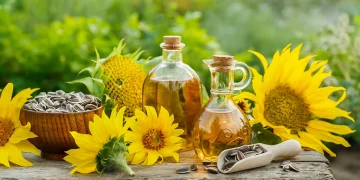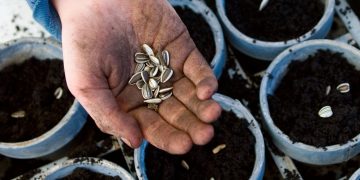Sunflowers are not only iconic for their golden blooms but also diverse in size, shape, and color. From giant varieties that tower above your garden to petite ones that thrive in pots, there’s a sunflower for every space and style. If you’re considering adding these cheerful plants to your garden, here are 10 types of sunflowers you should know about.
Top 10 Types of Sunflowers
1. Mammoth Sunflower

Height: Up to 12 feet
Best for: Large gardens and seed harvesting
Known for its towering height and massive flower heads, the Mammoth sunflower is a classic variety. It produces large edible seeds and serves as a natural privacy screen.Native Area: North America (hybrid of Helianthus annuus)
Known for its towering height and massive flower heads, the Mammoth sunflower is a classic variety.
2. Teddy Bear Sunflower

Height: 2–3 feet
Best for: Containers and small gardens
This dwarf variety features fluffy, double-petaled blooms that resemble pom-poms. Teddy Bear sunflowers are compact, making them perfect for borders or pots.Native Area: North America (cultivar of Helianthus annuus)
This dwarf variety features fluffy, double-petaled blooms that resemble pom-poms.
3. Autumn Beauty

Height: 5–7 feet
Best for: Colorful garden displays
Autumn Beauty sunflowers stand out with their vibrant shades of bronze, red, orange, and yellow. They bloom abundantly and bring a warm autumn feel to the garden.Native Area: North America (hybrid of Helianthus annuus)
Autumn Beauty offers shades of bronze, red, orange, and yellow, perfect for fall gardens.
4. Italian White Sunflower

Height: 5–7 feet
Best for: Unique floral arrangements
This elegant variety produces creamy-white petals around a dark center. Italian White sunflowers are loved by pollinators and work beautifully as cut flowers.Native Area: North America (cultivar of Helianthus annuus)
This elegant sunflower produces creamy-white petals around a dark center.
5. Russian Giant Sunflower

Height: 9–12 feet
Best for: Impressive garden focal points
Similar to Mammoth, the Russian Giant is famous for its massive flower heads and tall stalks. It’s a reliable choice for those wanting a dramatic sunflower display.Native Area: North America (introduced to Europe in the 1800s)
Russian Giant is a well-known heirloom variety prized for its enormous flower heads.
6. Velvet Queen Sunflower

Height: 5–6 feet
Best for: Bold color contrast
With deep red petals and a dark brown center, Velvet Queen adds a rich and dramatic touch to any garden. These sunflowers are also excellent for cutting.Native Area: North America (hybrid of Helianthus annuus)
With deep red petals, Velvet Queen creates a dramatic garden effect.
7. Sunspot Sunflower

Height: 2–3 feet
Best for: Kids’ gardens and small spaces
Sunspot is a dwarf sunflower that produces large golden blooms on short stalks. It’s easy to grow and makes a great choice for children learning to garden.Native Area: North America (cultivar of Helianthus annuus)
A compact dwarf sunflower with large golden blooms on short stalks.
8. Strawberry Blonde Sunflower

Height: 5–6 feet
Best for: Rare and eye-catching color
This unique sunflower features soft pinkish petals with golden tips. Its pastel hues make it an unusual yet stunning addition to any flower bed.Native Area: North America (modern hybrid of Helianthus annuus)
Features pastel pink and golden petals, unique among sunflower types.
9. Moulin Rouge Sunflower

Height: 4–6 feet
Best for: Dark, dramatic tones
Moulin Rouge sunflowers are striking with their velvety, burgundy-red petals. They’re pollenless, making them ideal for allergy sufferers and floral arrangements.Native Area: North America (cultivar of Helianthus annuus)
This pollen-free variety is prized for its velvety, burgundy-red petals.
10. Lemon Queen Sunflower

Height: 5–7 feet
Best for: Pollinator gardens
Known for its pale yellow petals, the Lemon Queen sunflower is not only beautiful but also beloved by bees and butterflies. It’s often grown to support pollinator populations.Native Area: North America (cultivar of Helianthus annuus)
Known for its pale-yellow blooms, it’s often grown to support pollinators.
















